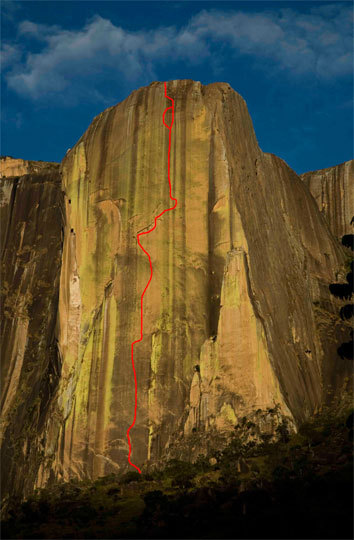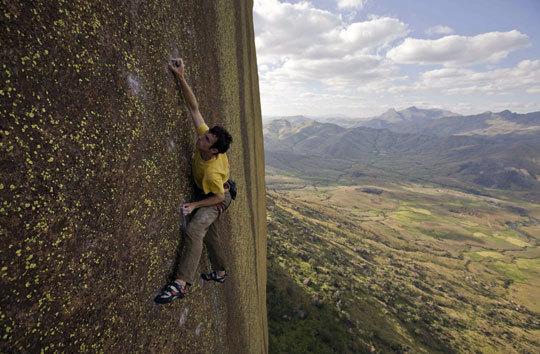
The west face of Karimbony, Tsaranoro Massif, Andringitra National Park, Madagascar. The route line depicts Tough Enough? (8c+, 12 pitches), recently established by David Pickford and James McHaffie. The crux pitch was redpointed by McHaffie after two days of effort. The route is a free variant of an unnamed aid line (8a A3, 400m, Gebel-Steiner, 2005). [Photo] David Pickford
Editor’s Note: The Tsaranoro Massif in southern Madagascar’s Andringitra National Park has seen much activity over the past decade, the majority of it–while bolted–very traditional in nature, as the reported ascents have predominately been made ground up and sparingly bolted–usually from stances or hooks. The fine, dense granite in the area offers few, if any, opportunities for natural protection. The line detailed in the report below, once freed, will certainly be one of the world’s most sustained in difficulty. Read about other climbs in this region in the following Newswires: November 28, 2006 ,November 28, 2006, June 1, 2007 and November 19, 2007.
In April, James McHaffie redpointed the first free ascent of the 8c+ [5.14c/d] crux pitch of a big-wall project in Madagascar’s Tsaranoro Massif. When every pitch of this route is climbed free, it will be one of the most challenging rock climbs on earth. McHaffie and David Pickford spent a week working on the 12-pitch project line on the 450 meter monolith of Karimbony known as Tough Enough?, which is based on the 2005 aid line (established by Germans A. Steinel and D. Gebel) up the center of the West Face.
The pair eventually climbed 6 pitches free, with McHaffie redpointing the crux 10th pitch after just two days of effort. This pitch is one of the world’s hardest slab routes in its own right, involving 40 meters of sustained technical climbing on an epic scale. McHaffie commented afterwards that it was “a whole grade harder” than Johnny Dawes’s Welsh masterpiece The Very Big And The Very Small (8b+/c) on Dinorwig slate, of which he made the 3rd ascent. McHaffie also redpointed the 9th pitch (8b) and the 3rd (8c), as well as onsighting pitch 4 (7c). Pickford redpointed the second pitch (8a) and onsighted the first pitch (7b+). Both these pitches had previously been climbed free by Francois Legrand of France, and Tony Arbonez of Spain in 2007 during their attempts on the line, when they also free climbed pitch 4 (7c), pitch 5 (known as the ‘Enduro Corner’, 8a+), and pitch 6 (dubbed the ‘Aloe Vera’ pitch, also 8a+).
The only pitches on the line that now remain to be free climbed are pitch 7 (a roof traverse thought to be 8c), pitch 8 (thought to be 8b+), and pitch 11 (also thought to be 8c). The complete list of pitch grades on Tough Enough? is likely to make even the most accomplished big-wall climber’s fingers sweat: 7b+, 8a, 8c, 7c, 8a+, 8a+, 8c, 8b+, 8b, 8c+, 8c, 6c!
France’s Arnaud Petit is currently in Madagascar to try the line. It is hardly necessary to point out that when free climbed in its entirety, Tough Enough? will be unquestionably the hardest big-wall free climb in the world.
The British team of Jack Geldard, David Pickford, James McHaffie and Stephen Horne also climbed an excellent new 4-pitch line on the right hand section of Lemur Wall, the long black cliff to the right of Karimbony. Yellow Fever (160 metres, 7a+ obl. / 7c max) climbs the striking yellow-gold streak on the steep wall to the right of Ebola. The first ‘Tarzan’ pitch climbs a chimney with a remarkable hanging vine to gain a belay, from where the second pitch (7b, redpointed by Pickford) makes a wild body-bridge out to gain a leftwards traverse across the wall. The crux pitch (7c) is a 50-metre, super-sustained and run-out monster, redpointed by Geldard and named the ‘Thunder Bird II’ pitch. The final pitch is a 6a+ and features some interesting run-outs. The team also bolted a direct start to the route up a rightward-trending line towards the second belay. Dubbed ‘The Sand Paper Simulator’, the finger-shredding pitch (roughly 8b+/c) was not redpointed by the Brits and remains an exacting challenge for aspirant Tsaranoro experts, preferably with a large supply of Aloe Vera!

McHaffie redpointing the crux 10th pitch (8c+) on his second day of effort. McHaffie commented afterwards that it was “a whole grade harder” than Johnny Dawes’s Welsh masterpiece The Very Big And The Very Small (8b+/c) on Dinorwig slate, of which he made the 3rd ascent. [Photo] David Pickford